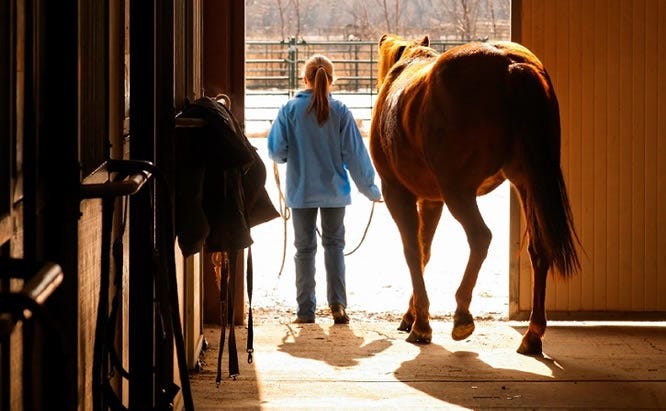Owning a horse is a rewarding experience, but it’s also a significant commitment. Unlike smaller pets, horses require extensive care, time, and financial resources. Understanding the essentials of horse care is the first step towards responsible horse ownership, ensuring your equine companion thrives. Just like providing for any animal, learning How To Care For A Horse involves understanding their unique needs and establishing a consistent routine.
Daily Stable Management and Horse Care Routine
Consistent daily care is crucial for a horse’s health and happiness. A well-structured daily routine ensures all their basic needs are met. This routine typically includes several key tasks performed morning and night:
- Feeding: Provide hay and/or grain at least twice daily, morning and evening. The amount will vary depending on the horse’s size, activity level, and the type of feed.
- Watering: Clean and refill water buckets or troughs with fresh, clean water twice a day. Horses need constant access to water, especially after exercise and in warm weather.
- Mucking Stalls: Remove manure and urine-soaked bedding from the stall morning and night. This process, known as “mucking out,” is vital for hygiene and preventing health issues.
- Fresh Bedding: Replenish stall bedding as needed to maintain a clean, dry, and comfortable environment.
- Hoof Care: Check and clean each hoof daily using a hoof pick to remove stones, dirt, and debris. Regular hoof care is essential for preventing lameness and maintaining hoof health.
- Blanket Management: During colder months, remove blankets in the morning if the weather warms up and replace them in the evening as temperatures drop. This helps regulate the horse’s body temperature and prevent overheating or chilling.
- Fly and Insect Control: In warmer months, apply fly spray or insect repellent morning and evening to protect your horse from biting insects, which can cause irritation and transmit diseases.
- Turnout: Allow daily turnout in a paddock or pasture. This provides essential exercise, allows the horse to move freely, graze, and enjoy fresh air and sunshine. Ensure the turnout area is safe and securely fenced.
- Exercise: In addition to turnout, horses need regular exercise several times a week. This can include riding in an arena or on trails, lunging, or other forms of controlled movement to maintain fitness and mental well-being.
 Loving hands gently grooming a horse's face, illustrating daily horse care
Loving hands gently grooming a horse's face, illustrating daily horse care
Understanding the Fundamental Needs of Horses
Horses are naturally grazing animals, designed to consume forage throughout the day. In their natural environment, they would graze continuously, taking in small amounts of food and water frequently. In a domesticated setting, we mimic this by providing regular meals of hay and ensuring constant access to fresh water. It’s important to manage their feed intake as horses don’t naturally regulate their food consumption and can overeat if given unlimited access to rich feeds, leading to health problems.
Cleanliness is also paramount, especially if your horse is stabled. Stalls must be kept clean and dry to prevent the build-up of manure and urine. A dirty stall becomes a breeding ground for flies and bacteria, and can negatively impact a horse’s hoof health and overall respiratory health. Daily stall cleaning is not just about aesthetics; it’s a critical aspect of responsible horse care.
Stable and Tack Maintenance: Extending Your Care
Beyond the horse itself, caring for a horse extends to maintaining their equipment and living environment. “Tack” refers to the equipment used for riding and handling horses, including saddles, bridles, halters, lead ropes, and blankets. Leather tack requires regular cleaning and conditioning to keep it supple, comfortable for the horse, and safe to use. Blankets and saddle pads should be laundered frequently to remove sweat, dirt, and mud, which can cause skin irritation and discomfort.
Stable chores are also a vital part of horse ownership. This includes sweeping aisles to remove dust and spilled feed, and removing cobwebs from the stable structure. Cobwebs accumulate dust, hay particles, and shavings, creating a potential fire hazard. A clean and well-maintained stable environment contributes to the overall health and safety of your horse.
Hands-On Learning: The Best Approach to Horse Care
While reading articles and books is helpful, the most effective way to learn how to care for a horse is through practical experience. Apprenticing with an experienced horse owner or professional is invaluable. This could involve spending time at a stable, asking questions, and observing daily routines. Taking riding lessons is another excellent way to learn basic horse handling and care under supervision. For a more immersive experience, consider leasing a horse, which allows you to take on more responsibility for daily care under the guidance of the horse’s owner.
By combining theoretical knowledge with hands-on experience, you’ll develop the skills and confidence needed for responsible horse ownership. Learning how to care for a horse is an ongoing journey, but one filled with immense satisfaction and a deep connection with these magnificent animals.
Conclusion: Dedication and Love in Horse Care
Caring for a horse is indeed a labor of love. It requires dedication, time, and a willingness to learn and adapt. By understanding their needs and committing to a consistent care routine, you’ll ensure your horse’s health, happiness, and well-being. The rewards of horse ownership are immeasurable for those who are prepared to provide the comprehensive care these animals deserve.
